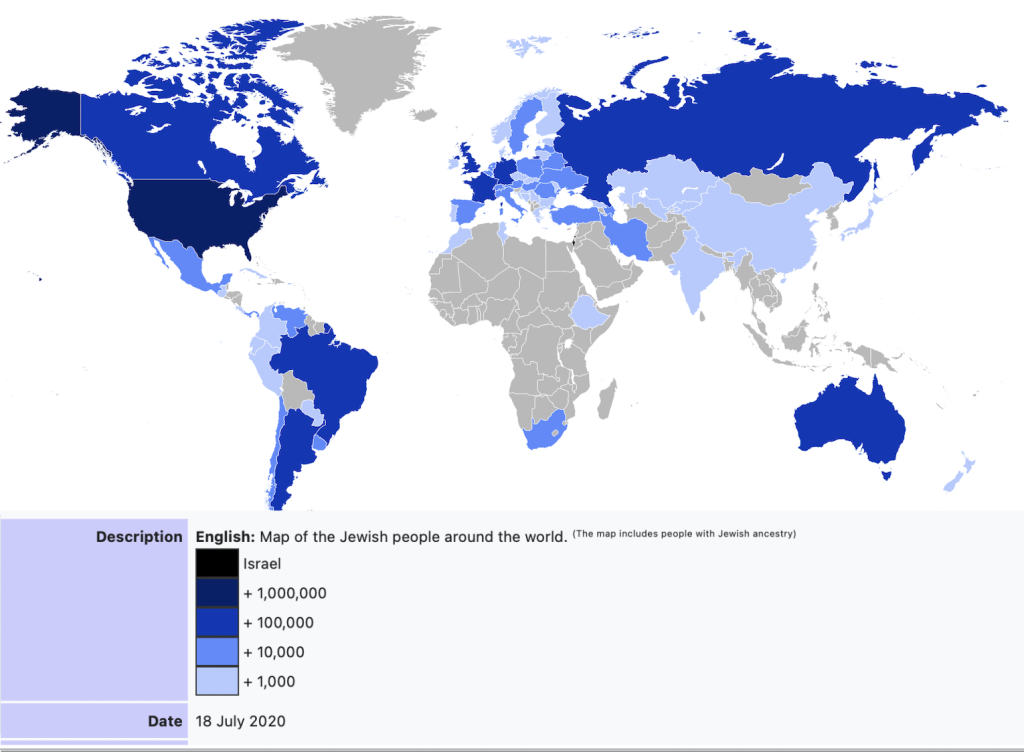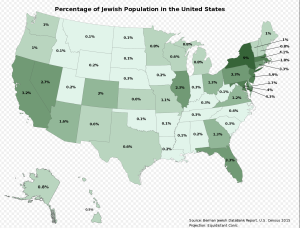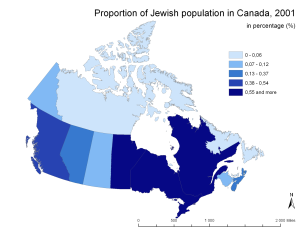Chapter 8: The Geography of Religion
8.4.5 Judaism
Religion
Judaism is an ethnic monotheistic religion originating in the Bronze Age in the eastern Mediterranean. Although it has no single founder, it holds the Torah as its holy book. In the modern context of Judaism, there are three major branches: Orthodox, Conservative, and Reform—each with its own set of interpretations of correct practice. Judaism, as the initial Abrahamic religion, influenced other religions (particularly Christianity and Islam). Jews believe God established a covenant/agreement with them and communicated through prophets. Moses, their most important prophet, received their holy book, the Torah (the first 5 books of the Old Testament, the Christian Bible), directly from God. Jews worship in a synagogue and believe the Messiah, the savior, will come someday.
Diffusion
According to the Jewish Agency for Israel, the Jewish Population Rises to 15.3 Million worldwide, and over 7 Million reside in Israel.
While Jews historically have been found all around the globe, Judaism is highly geographically concentrated today. More than four-fifths of all Jews live in just two countries: the United States and Israel. Israel is the only country with a Jewish majority, with 76% of the population being practicing Jews. Territory-wise Israel is so small that it can only be glimpsed as a speck on the map Figure 8.5.4.1 below.

Source: “Map of the Jewish Diaspora in the World” by Allice Hunter via Wikimedia Commons is licensed under CC BY-SA 4.0.
The largest remaining shares of the global Jewish population apart from the U.S. and Israel are in Canada (about 3% of the country’s population), France (2%), the United Kingdom (2%), Germany (2%), Russia (2%) and Argentina (between 1% and 2%).

Source: “Jewish Percentage Population, United States” by Irvadm via Wikimedia Commons is licensed under CC BY-SA 4.0.
In the United States many of the 7.5 million Jews prospered throughout the early 21st century. According to a 2016 study by the Pew Research Center, the Jewish ranked as the most financially successful religious group in the United States, with 44% of Jews living in households with incomes of at least $100,000, followed by Hindus (36%), Episcopalians (35%), and Presbyterians (32%), though owing to their numbers, more Catholics (13.3 million) reside in households with a yearly income of $100,000 or more than any other religious group. The 2021 Forbes 400 includes several Jews among the top 10 wealthiest Americans. American Jews are disproportionately represented in business, academia and politics.

Source: “Canada-jewish-population” by Faigl.ladislav via Wikimedia Commons is in the public domain.
In 2011, Canada counted almost 400,000 Jews (1.2% of the Canadian population) with most of them living in the Province of Ontario followed by Quebec. Since the start of the 21st century, Jewish immigration to Canada has steadily increased. Due to rising antisemitism in France and poor economic conditions, many French Jews, seeking better economic prospects, have chosen Canada, especially Quebec, as a top destination alongside Israel. Similarly, the cultural and linguistic similarities have prompted many Belgian Jews to relocate to Canada.
Appearance in the Cultural Landscape

Source: Photo by Barbara Crain, 2022 | CC BY 4.0.
Judaism in the cultural landscape can be identified through various symbols, structures, and community practices that reflect Jewish religious and cultural heritage. In particular, there are synagogues serving as central places where a Jewish assembly or meets for religious worship and instruction. Architectural features often include the Star of David, menorahs, and Hebrew inscriptions.
Jewish cemeteries are distinctive with their Hebrew-inscribed headstones, often adorned with symbols like the Star of David, menorahs, or the Cohen’s hands (a symbol for the priestly class). Jewish community centers (JCCs), Hebrew schools, and yeshivas (Jewish religious schools) provide education and community services, often featuring Hebrew language signs and Jewish symbols. Public observance of Jewish holidays such as Hanukkah, Passover, and Rosh Hashanah, including menorah lightings in public spaces or sukkahs (temporary huts) during Sukkot, are visible cultural clues.

Source: Photo by Barbara Crain, CC BY 4.0.

Source: Photo by Barbara Crain, CC BY 4.0.
Jewish neighborhoods are often distinctive with names reflecting Jewish heritage or historical significance. Neighborhoods with high concentrations of Jewish residents, often showcase synagogues, kosher eateries and grocery stores, and butcher shops that advertise kosher food, adhering to Jewish dietary laws, are significant cultural markers.
Monuments, plaques, and museums dedicated to Jewish history, including Holocaust memorials, contribute to the cultural landscape of many European countries where atrocities to the Jewish people were committed by the Germans and their supporters.

Source: Photo by Barbara Crain, CC BY 4.0.

Source: Photo by Barbara Crain, CC BY 4.0.

